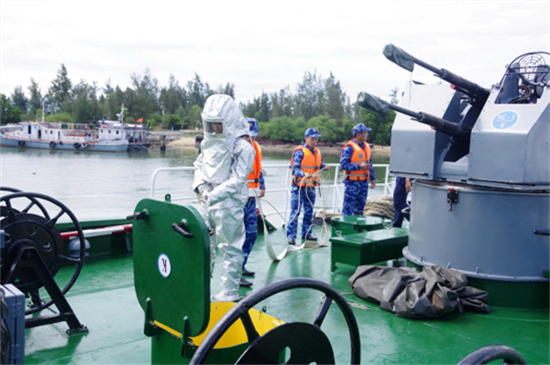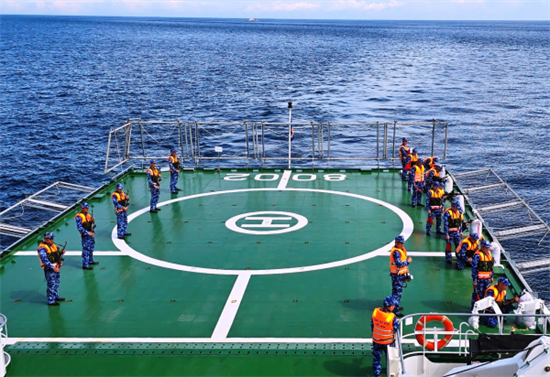Over the years, Squadron 21, under Coast Guard Region 2’s Command, has always regarded training and combat readiness as a central, consistent political task that has directly contributed to building “exemplarily, typically” comprehensively strong affiliates, raising its synergy and combat strength, and meeting its task requirements.
Squadron 21 is tasked with managing and ensuring security and safety over a vast sea, with complex weather, climate, hydrographical conditions, criminality, and violations of Vietnam’s law and national sovereignty, especially by foreign ships. To successfully fulfil their tasks, the Squadron’s Party Committee and Command have focused their leadership and direction on all pieces of work, particularly on the improved training and combat readiness quality via synchronised, effective measures.
 |
| Training troops on how to use search and rescue equipment |
First of all, for the sake of the raised quality of training and combat readiness, the Squadron has enhanced the leadership and direction of all-level party committees and commands and regularly carried out education and propagation work to foster awareness and a sense of responsibility among its cadres and soldiers. It has grasped and implemented higher echelon’s resolutions and directives on training and combat readiness, particularly Resolution 1659-NQ/QUTW, dated 20 December 2022, by the Central Military Commission, Resolution 800-NQ/ĐU, dated 27 March 2023, by the Vietnam Coast Guard (VCG) Party Committee, and Resolution 524-NQ/ĐU, dated 5 April 2023, by Coast Guard Region 2’s Party Committee on raising the training quality in the period of 2023 - 2030 and beyond. The Squadron Party Committee and all-level party committees have concretised those documents into guidelines and measures relevant to their particularities and task requirements. Commands of offices and units have proactively developed training and combat readiness programs and plans.
Offices and units of the Squadron have regularly carried out education work to raise awareness and a sense of responsibility among cadres and soldiers towards training and combat readiness. Great value has been attached to grasping and clarifying viewpoints, objectives, and targets relating to training and combat readiness for each group of troops. The exemplary role of cadres and party members has been heightened, while key cadres’ responsibility has been directly aligned with the performance of training and combat readiness tasks. As a result, the Squadron has promoted a sense of responsibility in leadership and direction to proactively overcome difficulties and successfully fulfil training and combat readiness missions.
The Squadron has actively renewed its training content and methods under the motto of “basics, practicality, solidity”. Consideration has been given to making elaborate preparations for training. In addition to repairing and building training models and grounds, the Squadron has proactively developed training plans and schedules in a comprehensive, scientific manner; training documents, materials, records, and statistics have been standardised under regulations on training staff work. Due regard has been paid to strictly maintaining regulations on reviewing and approving lesson plans before each training phase. The Squadron has concentrated on consolidating and stabilising its organisational structure, holding refresher courses to ensure uniformity in training content and methods, especially for new issues and modules, thus improving the quality of its training staff at all levels, meeting the requirements of training commanders, offices, and units simultaneously. As a result, the professional qualifications and training capabilities of cadres at all levels have been significantly raised; 100% of cadres have been capable of training work at their levels; over 75% of them have been rated good or excellent in training work.
 |
| Live-fire exercise at sea in 2025 |
Training work has been managed and operated methodically, scientifically, creatively, effectively. The Squadron has organised comprehensive but focalised training courses, with priority given to vessels performing their duties at sea. Units of the Squadron have been required to adhere to the training motto, viewpoints, principles, and connections and focus on synchronised, specialised training, with sovereignty protection, and law enforcement, and the building of a modern VCG as the goal of training. Based on the prescribed training framework, its assigned tasks, and the characteristics of its operational areas, the Squadron has flexibly supplemented additional training content and tightly combined curricular and extracurricular training. Training courses have been closely linked to real-world conditions and tailored to each group of troops. Great value has been attached to improving coordination, staff work, command, technical and tactical skills, endurance at sea, and the capability to effectively handle complex maritime situations.
For the Coast Guard specialty, the Squadron has grasped and seriously realised all documents related to the VCG’s professional duties, introducing maritime operational principles and countermeasures to every cadre and soldier, studying vessels’ equipment as the basis for designing future training phases for vessel cadres and technical staff. It has directed its vessels to closely monitor the overall situation, grasp their task requirements, adhere to the principle of “training from basic to advanced, from simple to complex”, and harmoniously combine specialised theoretical training at the base with single-ship tactical training at sea. It has focused on training its troops to master existing and new equipment and increasing night-time and complex-condition training. At the same time, it has closely combined training with political education, regularity building, discipline management, and safety assurance in order to foster discipline-abiding awareness among its cadres and soldiers in the training process. It has regularly conducted inspection and supervision to ensure training consistency, programs, content, and schedules for all groups of troops. Thanks to those synchronised, effective measures, the Squadron’s training quality has considerably improved. 100% of its troops have passed annual political education testing; over 80% of them have been rated good or excellent. Military, logistics, technical, legal, and professional training has been highly appreciated by higher echelons.
While raising its training quality, the Squadron has fully complied with directives and guidance on combat readiness, enhancing the quality and effectiveness of situational monitoring, analysis, assessment, and forecast, promptly giving advice on handling incidents to ensure maritime safety and security in its assigned waters. Units of the Squadron have frequently conducted education work to render all troops fully aware of the characteristics of adversaries and hostile forces’ plots and tactics, proactively designing, supplementing, and perfecting regular and long-term operational documents following administrative boundary adjustments. The Squadron has actively practised its combat projects, improving its troops’ physical endurance, enhancing its affiliates’ command, coordination, and manoeuvrability. More specifically, the rapid response force assisting civilians ashore has been trained to be deployed within 30 minutes; the patrol and search-and-rescue force for distant seas has been trained to depart on mission within 2 hours; the force in charge of contingency tasks at sea have been trained to set sail within 30 minutes; the mobile repair force has been trained to operate within 2 hours. The Squadron has taken part in and organised one-side, two-level command and staff exercises both on maps and in the field under combat scenarios. It has practised projects on shifting combat readiness states and held tactical and live-fire exercises at sea with absolute safety for personnel, ships, and equipment. The Squadron’s general and live-fire exercises at sea in 2025 have been well organised with absolute safety; it has also participated in “LT-25” and “VTH-25” combat readiness transition drills and successfully completed joint training exercises with the Philippine Coast Guard.
The Squadron has focused on making a breakthrough in raising the quality of situational monitoring, analysis, and evaluation, promptly proposing suitable force adjustments to handle maritime incidents properly. It has closely collaborated with other forces in exchanging and verifying information, firmly grasping the situation regarding national sovereignty, social order and safety, and criminality in its area of responsibility, thus avoiding passivity in all circumstances. Vessels of the Squadron have been tasked with combat readiness at islands, patrols, law enforcement, and IUU fishing combat in the seas of responsibility simultaneously. The Squadron has actively taken part in forward command posts, conducting information dissemination, driving foreign fishing boats out of Vietnam’s waters, firmly protecting national sovereignty, maintaining law enforcement to ensure order and safety in its designated maritime areas.
Additionally, the Squadron has strictly implemented measures for maritime safety assurance and regularly maintained forces to monitor weather, meteorological, hydrological conditions and navigational changes to opportunely report to the Region Command. Surveys and studies on sea routes, storm shelters for ships, port facilities, and storm-resisting buoy networks have been carried out to ensure vessels’ safety in adverse weather conditions. It has closely coordinated with relevant agencies to receive and process search-and-rescue and maritime security information in a timely, procedural manner, giving advice on the use of forces in search and rescue operations, bringing rapid, effective response to incidents, ensuring absolute safety for vessels at sea.
The Squadron has always provided effective logistics and technical support for training and combat readiness. Based on its task requirements, the Squadron has sufficiently developed a system of logistics and technical documents for both routine and combat readiness operations in accordance with regulations. It has directed its offices, units, vessel messes, and vessels to ensure food supply and safety for troops’ daily meals. At the same time, it has strictly maintained technical work, proactively inspecting maintenance activities, sustaining technical readiness levels, ensuring sufficient quantity, high quality, and synchronicity of vessels, vehicles, and other pieces of equipment. It has also guaranteed adequate reserves of materials, supplies, and means for combat readiness and contingency missions under regulations, with a view to readily undertaking any assigned mission and contributing to firmly protecting national sovereignty and security in the sea of its responsibility.
Colonel LE TRUNG THANH
Deputy Commander and Chief of Staff of the Squadron